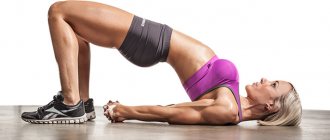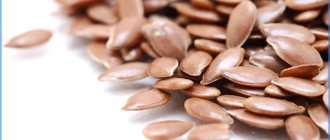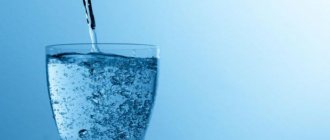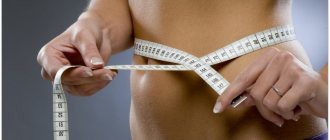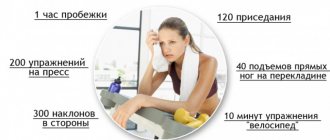Greetings friends! Whatever type of physical activity we engage in, the main goal should be one - health. But even a physically developed body cannot always be in balance with internal health and consciousness.
Unfortunately, most training systems do not pay enough attention to this aspect. Meanwhile, problems with excess weight are often the result of stress and internal contradictions, as well as an inability to feel your body. The Pilates system was created to correct the situation. And today we will find out whether Pilates is effective for weight loss, reviews of which are not always positive.
What is Pilates?
Pilates is a system of exercises whose main goal is to develop the body and mind. It is so multifunctional that in addition to developing physical strength, flexibility and coordination, it helps relieve stress, enhances concentration and improves body control.
The creator of Pilates is Joseph Pilates, who with all his heart wanted to help people with disabilities feel all the delights of a full life. His technique allows you to work all the muscles of the body as carefully and concentratedly as possible.
Training using this system is distinguished by a very special approach to working with muscles, full concentration on movements and control of breathing. Despite the fact that Joseph Pilates did not formulate the postulates of the system he developed, several basic principles can still be identified.
- Breath.
Breathing itself is of utmost importance to life. In Pilates, it is the core on which all other principles are based.
- Concentration.
The ability to concentrate on a specific goal is very important for proper mastery of the exercises. Without following this principle, you will not be able to fully realize your potential.
- Finding the center.
An ambiguous postulate. Its meaning primarily lies in finding the starting point of the vital energy of the body, from which any movements originate. A more earthly interpretation is to find the center of gravity of the body. The very point around which the body mass is evenly distributed. If you don’t find it, you will spend a lot of extra effort when doing the exercises, which will affect the results of the exercises.
- Control.
Skills to control your movements are necessary to perform exercises without errors. Over time, you should develop it to the point of automaticity and control only the smallest details.
- Accuracy.
The quality that distinguishes Pilates from other exercise systems. Each movement must be performed strictly according to the instructions. There are many exercises in Pilates that are identical to exercises from other training methods, but they differ in the nature of their implementation. To master this principle perfectly, it is necessary to understand the anatomy of the human body. This is the only way to use isolated muscles and synchronize their work with the rest of the muscles involved.
- Smoothness.
Exercises should be performed smoothly. That is, sharp transitions between movements are not allowed. Imagine yourself as a python, here is an example of smoothness. To fully master the art of Pilates, you must follow all 6 principles of the system. Then, in addition to improving your body, you will strengthen your consciousness, which will greatly help you in everyday life!

Does Pilates help you lose weight?
Pilates is a set of calm, measured physical exercises with moderate physical activity. Therefore, the question of whether it is really possible to lose weight using this technique worries many women.
The answer to this question: “Will Pilates help you lose weight?” can be answered in the affirmative. Pilates is not only about calm movements accompanied by slow music. Pilates is also an effective way to lose weight and improve your health. The principle of the technique is to accurately perform the exercises together with proper breathing. This method, even with seemingly insignificant loads, allows you to burn a lot of calories during training and strengthen the muscles of the whole body. Pilates exercises for weight loss do not require special skills, and therefore are available to everyone.
Many exercises may seem easy, but doing them the first time is quite difficult, especially for people without proper physical training. Therefore, Pilates is one of the optimal solutions for losing weight.
Pilates for weight loss
During Joseph Pilates's lifetime, his system did not become widespread. Only through the efforts of his followers did Pilates gain worldwide popularity. Along with its development, new varieties of this method appeared, adapted to certain segments of the population. The amount of exercise also increased steadily.
Despite the low energy consumption, about 300-400 kcal per hour-long workout. Pilates is good because it affects deep-lying muscles. Thus significantly improving blood circulation and oxygen supply to muscles.
In accordance with the postulate of finding the center, the considered system of exercises has the main goal of developing the muscles of the abdomen, lower back, buttocks and thighs. And stimulation of these areas leads to improved functioning of the digestive organs and, as a result, better absorption of nutrients.
As mentioned earlier, the creator of Pilates wanted to achieve not only an impact on the physical component, but also on the spiritual one. Spiritual balance, as you know, is one of the ways to a slim figure!
The basis of the system is exercises performed mainly from a lying position or from a lying position. This may include:
- Exercises for the abdominal muscles (leg circles, crunches with forward bend, hundred, tough nut, criss-cross).
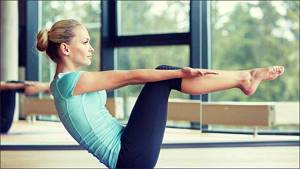
- Flexibility and precision exercises (back stretch, back roll, crab, seal, rocking chair, boomerang).
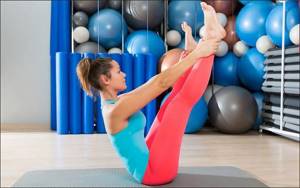
- Hand-supported exercises (shoulder bridge, scissors, bicycle, push-ups)

- Tilts and turns of the body (swings with legs while lying on your side, swings with legs while kneeling, twists of the body while sitting, saw, screw, corkscrew)

- Back stretching and strengthening exercises (cat stretch, heel kick, double kick, swimming, belly roll, diving swan)
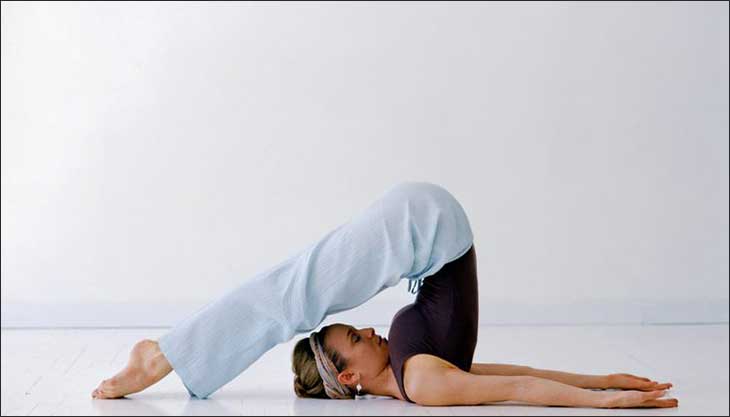
It is advisable to create a complex and start performing exercises under the supervision of a trainer. But if you are confident in your abilities, then independence is not prohibited. Just keep in mind that for results you need a strict regime - training at least 3 times a week for more than 40 minutes. And get your diet in order!
Pilates training can be supplemented with callanetics exercises. This system is different in that it is based on static exercises. It will allow you to develop flexibility, which will have a positive effect on your Pilates classes. In addition, callanetics does not require frequent training (1-2 times a week will be enough).
I advise you to watch a video on Pilates, where an experienced trainer will show you the correct technique for doing the exercises.
To ensure that your workouts are not boring, I recommend practicing against the background of rhythmic music. Moreover, there are tracks specially selected for Pilates. I advise you to check out the compositions of 2016, you won’t regret it.
Exercises for weight loss
When asked whether Pilates helps you lose weight, experts answer positively. But to get results and eliminate cellulite on the legs and thighs, you must perform the movements correctly, in a certain order and constantly.
An approximate set of exercises for weight loss looks something like this:
- Lying on your back, lower limbs bent, feet slightly apart and parallel . The upper limbs are extended along the body, palms up. As you inhale, your knees turn to the left and your head in the opposite direction, your upper back should be pressed to the floor, your pelvic muscles and abs tense. As you exhale, lie down and relax. A 10-fold repetition is recommended.
- Lying on your stomach, arms along the body, legs closed . Inhale air and stretch, then exhale and lift one leg, stop a little in this position and return to the original position. Repeat with the other leg, up to 10-12 times in total.
- Lying on your side, legs straight and closed, the opposite arm bent and resting on the floor in front of the chest. The second is extended lengthwise. As you inhale, stretch along as much as possible, while exhaling, tighten the muscles of your pelvis and abdomen. Raise your leg up, smoothly and slowly, with your foot pulled towards you. Fix the highest possible position of the lower limb for 30 seconds. Repeat on each side 15 times.
- Sitting with straight legs, support your hands. The back should be straight. Raise your lower limbs 45 degrees and perform circular movements with them to the sides. Repeat up to 10 times; for beginners, you can make the task easier by focusing on bent arms. For more trained people, you can increase the number of repetitions to 20 times.
- Sitting with knees bent, feet flat on the floor . Hold your feet with your hands and lift your legs, spreading their sides. Stay in this pose for five breathing movements. Then connect your legs and stand for the same amount of time. Then take the starting position and relax. Repeat 5 times. For those who find it difficult at first, you can grab the ankle instead of the heels. It is very important to keep your back straight and your abdominal muscles tense.
Important ! During Pilates classes, many people ask the trainer if it is possible to lose weight this way. In fact, losing weight is easy, because a lot of energy is spent on stretching muscles and increasing their tone. But at the same time, you also need to follow the principles of a healthy diet and lean on vegetables and fruits.
Reviews of Pilates for weight loss
Since the Pilates system was invented for the rehabilitation of people after injuries, the reviews from doctors are extremely positive. Unfortunately, the practice of using it for rehabilitation in our country is not as developed as in the USA. But many rehabilitation therapists, having tried Pilates only once, begin to practice it on an ongoing basis. In addition, they note a positive effect on excess weight.
On weight loss forums, many people speak negatively about Pilates as a means to combat excess weight. But don't rush to conclusions. It is good because it gives a slow result, but at the same time long-term. Because it leads to deep reconfigurations of the body! With the right approach, you will change not only your appearance, but also your consciousness. Which, you see, is much more valuable!

And instead of before and after photos, I suggest you evaluate the form of the father of the training system - Joseph Pilates.
Agree, he looked simply excellent for his age! So draw your own conclusions, friends. With this I say goodbye to you, subscribe to blog updates and share useful information with your friends and acquaintances on social networks. See you soon!
Reviews
If you decide to do Pilates for weight loss, for inspiration you can read reviews about it on the forums and see the results of such training . Many people notice an improvement in their condition after they start doing exercises regularly.
Strengthening the abdominal muscles is also a useful bonus when burning fat and eliminating cellulite on the legs and thighs. Pilates classes are especially popular for those who do not like jumping, squats and making sudden movements.
The most positive reviews are left by those who were able to not only force themselves to exercise regularly, but also stopped eating flour and sweets. Some were able to reduce weight by 4-6 kg in one or two months. Gradually, training becomes a habit, and a person feels pleasure from doing exercises and stretching muscles.
Losing weight with Pilates
There are 3 types of exercises aimed at losing weight: on machines, on the floor, and with special equipment. They train without shoes. Choose calm music that gets you active but not distracting.
Exercise "Boat"
You need to sit on the floor, bend your knees, and clasp your thighs with your upper limbs. Feet are pressed to the floor, legs are the width of your pelvis. We stretch ourselves up with the top of our head, while straightening our back. Lift your feet off the floor and raise your ankles parallel to the ground. We linger in this position for 3-4 seconds, monitor our breathing, it should be smooth, without delays. We inhale deeply, and as we exhale, we draw the abdominal muscles towards the spine, while rounding the spinal column. We take the next breath, straightening our back. We repeat the algorithm.
Exercise "Cancan"
Starting position: sitting on the floor. Legs are bent at the knees. We lean on our forearms, our elbows are strictly under our shoulders. The toes of the lower extremities barely touch the ground, and the legs are compressed. we pull in our stomach, taking a deep breath, and at the same time turn our knees to the right. As you exhale, straighten your legs, raising them diagonally to the body. On the next inhalation, you need to return the body to its original position. We repeat the same for the left side, and then again for the right. Repeat on each side several times.
Exercise "Criss-Cross"
Initially, we lie on our back. The legs are bent and raised so that the ankles are parallel to the ground. We spread our elbows to the sides, holding our hands behind our heads. Your back should be pressed to the mat and your stomach should be pulled in. Inhale and lift your head off the floor along with your shoulder blades. This is followed by an exhalation, during which we straighten the right leg so that it becomes at an angle of 45˚ to the floor. There is no deflection in the lower back. We turn our whole body to the left. This is followed by an inhalation, with which we return the body back, while the shoulder blades do not fall. On the next inhalation, we repeat the same movements, but on the second side.
Exercise “Plank Pose”
You need to get on all fours, leaning on your forearms. Make sure your elbows are directly under your shoulders. Our knees are in line with our hips. We straighten our legs successively and move them back, placing them on their toes. Make sure your feet are pressed together. We straighten the body completely. When it forms a line, it is a bar. Inhale in this position. As you exhale deeply, raise your hips and lower your head, moving into the so-called dolphin pose. Next, we inhale and return the body to its starting position.
Exercise "Leg Swing"
We stand on our hands and feet (all fours), straighten our arms, our hands are in line with our shoulders. Legs in line with hips. First we straighten the left and then the right leg (not sharply), take it back and place it on the toe. We maintain balance with the help of our toes, feeling the weight of the body on them. The feet are pressed against each other.
Lower your hips so that your body forms a straight line. We inhale and at the same time raise our leg, exhale and lower our leg. We perform the exercise 3-4 times, alternating left and right legs.
Exercise "Mermaid"
Bend your knees and sit on your right thigh so as to feel comfortable. With the right upper limb, we place emphasis on the floor, straighten the elbow, and place the arm 10-15 cm away from the body, but no more. Place your left hand, palm up, on your left knee. Inhale and push with your right upper hand, raising your hips at the same time. In the same movement, the left hand reaches up towards the ceiling. The pose resembles the shape of the letter T. We exhale and gradually return to the original pose. Inhale, exercise on the other side. Repeat several times for each side.
Exercise "Pica"
We lie on the ball, slowly move our hands forward along the floor so that the ball is located under the ankles. Keep your body parallel to the ground, palms under your shoulders. We tense our stomach and inhale deeply gradually. We exhale and raise our pelvis at the same time (legs remain straight), rolling the ball in the direction of our hands. This is followed by inhalation and repetition of the algorithm described above.
Exercise “Twists of scissors”
We lie on our back, holding the ball between our shins. The arms are at the sides at shoulder level, palms pointing down. We bend our knees at a right angle, lift the ball, squeezing it with our legs. Next, inhale, and as you exhale, lower your legs with the ball to the right, while your shoulder blades lie clearly on the floor. With the next breath of air we return back. As you exhale, repeat the algorithm for the second side.
Exercise "Back stretch"
We sit on the ball, spread our legs as wide as possible and reach out to the ground with our hands. The muscles of the shoulders, neck and back should be absolutely free of tension. Breathe evenly, without delay, slowly.
Exercise “Abs Stretching”
Starting position: walking on the ball. Walk forward in small steps, at the same time we lean back and lie with our lower back on the ball. The head and shoulder blades should lie on it, arms spread on both sides of the body. The head, pelvis and back muscles should fit in the ball. The lower back and abdominal muscles should not be tense. Stretch slightly.
Who is the Pilates complex suitable for?
This set of exercises is suitable for women and men, girls and boys. There are no age restrictions, just as physical fitness is unimportant. Pilates will solve the following problems:
- stress
- back pain
- osteoarthritis
- osteoporosis
- spinal injuries
- neurological headaches
- recovery from severe injuries
- obesity
Pregnant women can also do Pilates. The system will help tone the muscles of the pelvis, abdomen, and back, so that after childbirth you can restore your previous figure in a short time.
Pilates effect:
- getting rid of negative emotions and thoughts
- rejuvenation of the body as a whole
- a surge of strength, a desire to act
- lack of sleepiness during the daytime (with regular exercise for at least 8 months)
Practitioners claim that Pilates affects brain function and memory.
Contraindications for Pilates
Anyone can do Pilates. If you have any doubts related to advanced age, heart condition, or serious illnesses, consult your doctor. But remember that the doctor must understand what the Pilates system is and not put it on the same level as other physical activity systems. After all, we have already discussed above how the Pilates system differs significantly from aerobics or shaping, which not everyone can do.
Don't hold your breath while doing the exercises. This way you will burn extra pounds faster because your body will receive enough oxygen. Exercises should not be done inconsistently or with incorrect technique, otherwise you risk harming yourself. Every moment of technique is essential, even if you don't think so. Avoid jerking and sudden changes in position. If you feel unwell during class, immediately inform the trainer. If you are training at home and feel sick, call for help and call an ambulance.
